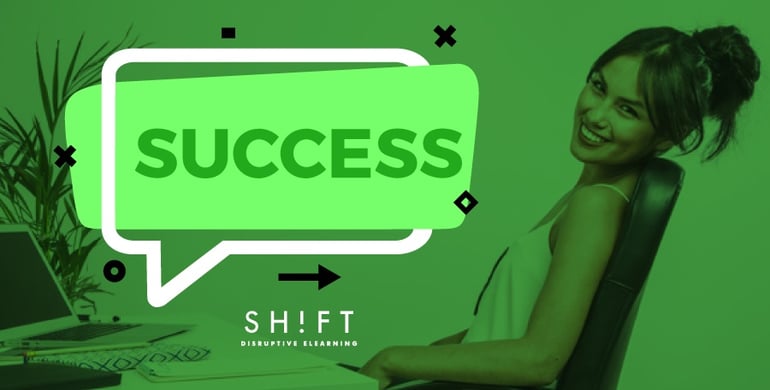Now what?
So you’ve decided to take your training online. There is an audience eager to access your expertise, you’ve narrowed down your topics, you’ve have identified your target audience, and you’ve even selected an authoring tool. Now what?
Despite the common assumption, developing a successful eLearning course is not as simple as transferring your Powerpoints to an online environment. However, it’s not rocket science either. The secrets to eLearning success lie in between purposeful planning and engaging interaction.

Eager to help you tackle the tasks ahead, we’ve listed four pillars we have defined as the keys to success. This guide will serve as the foundation for each of the eLearning courses you build in 2018.
1) It’s Worth The Read: Providing High-Quality Content
Visuals are important. Engagement is extremely important. However, these come second to the key element of your course: content. Making sure it’s easy to follow, and engaging will do little if what you are presenting is adding little value to the learner.
But what do we mean by high-quality content?
- High-quality content is content that RESONATES with your audience. This is the only kind of content that keeps people reading, from start to finish. It’s the only kind that elevates your course from ordinary to great.
- High-quality content is information that is straightforward and useful. Avoid general information, focus on what’s meaningful and relevant to the course subject. What will learners lose if they don’t complete a task? It’s a question you should encourage students to ask themselves all the time throughout your course.
- It’s extremely useful to the learner if you further develop essential points to include examples and insights that students can re-apply in real life scenarios. All learners want to feel is that they are achieving something while learning. Use a good context that shows how they are going to use this information; not a poor context that makes them feel they’re wasting time.
Which leads to the next point.
2) Real Life Relevance
The belief or thinking comes before the act. You need to remember this when you are creating your course. Your learners are here because they are eager to acquire the information and understanding that will develop the skills that they need to excel. This says real life all over it, so it’s important to keep in mind that real people will be using this content to make real changes. People will always feel there is value in what they are doing if its helpful in everyday life.
Guarantee success with these tips:
- Use relatable images and discuss real-life situations when addressing concerns, doubts, or processes. They will think of the course the next time they are in a situation and refer to what they’ve learned.
- Tap into emotions like intrigue and motivation. It’s easier to absorb information if you are having fun or if you are engaging in an activity without realizing that you are learning. Use features provided by your platform or other sites (Youtube, etc.) to help you do this.
- Adapting for mobile. The on-the-go culture is undeniable. Having small portions of the course (whether it’s games or exercises) in mobile format would allow to maximize the experience and making the most of downtime.
- Exploration is key to the learning process and adding activities as possible to do this on their own time can keep them coming back for more.
Ask yourself: Would I read/watch this course? If the answer is “no,” then you know you are doing something wrong. Before you publish your course, review these items to make sure it is worth taking.
Also read: Keep eLearning Real: 4 Basic Story Types to Link Learning to the Real-World
3) Add the human element: Learning with Others
Social learning can provide the sense of a classroom dynamic. Among the features that your platform may provide, a forum is always a great place for students or employees to further discuss the course. Encouraging group interaction can add the “human element” that isn’t as present online.
Solving problems collectively can help bring up questions or concerns that will help you identify where to further develop points. Students are open to sharing their experiences. Social learning invites sharing points of view, which will always add perspective and be useful to their advancement.
Must read:
- The Why’s and How’s of Social Learning in the Workplace
- Targeting 6 Social Learning Needs in eLearning Environments
4) Staying Friendly to Learners
So you think its user-friendly, but you aren’t sure? Here’s a shortlist of questions to ask. Instructional designers make sure all these points are covered before moving forward. And run down the list with your team, applying these user experience tricks to your course development.
- Is your course easy to navigate?
- Is your course easy to read? Is the appearance of the screens overwhelming? If so, what can you remove to make it a pleasing visual?
- Is the student’s progress easy to follow? Is it clear which lessons have been taken, and which are still missing
- Are the additional learning experiences such as games, forums, and links all active and easy to access?
- Are there milestones after lessons to test progress or determine whether or not the student has understood the material?
Useful resource: Don't Frustrate Your Learners! 7 Rules for Creating User-Friendly eLearning
Best of luck in your eLearning endeavors in 2018!
These four pillars are probably nothing new to experienced eLearning developers. However, it’s crucial for newbies to have a clear understanding of what successful courses have in common to build courses that drive results.
Look forward to hearing your stories and insights in the comments below.







